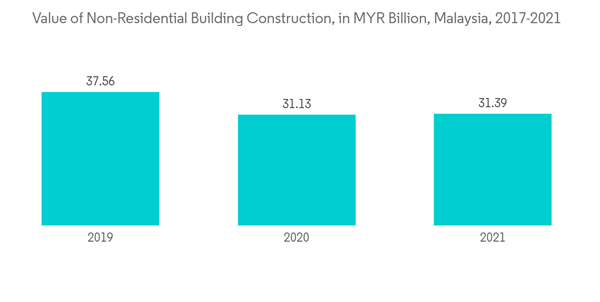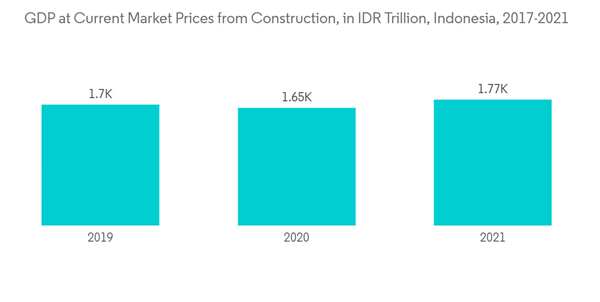The Southeast Asia anchors and grouts market is anticipated to register a CAGR greater than 4% during the forecast period.
During the COVID-19 outbreak, there was a negative impact on the anchors and grouts market in the Southeast Asia region as construction projects in the residential and commercial sectors came to a halt. The Southeast Asia anchors and grouts market recovered from the pandemic and is growing significantly.
This product will be delivered within 2 business days.
During the COVID-19 outbreak, there was a negative impact on the anchors and grouts market in the Southeast Asia region as construction projects in the residential and commercial sectors came to a halt. The Southeast Asia anchors and grouts market recovered from the pandemic and is growing significantly.
Key Highlights
- Over the short term, expansions of petrochemical plants and significant development in the construction industry are projected to fuel market growth throughout the forecast period.
- However, it is estimated that VOC emission restrictions and a shortage of skilled workforce are the major factors that are likely to hamper the growth of the Southeast Asia anchors and grouts market size.
- Nevertheless, increasing technological innovations in the construction industry and a greater emphasis on green building materials will likely create lucrative delivery opportunities for the Southeast Asia anchors and grouts market over the forecast period.
Southeast Asia Anchors & Grouts Market Trends
Non-Residential Segment to Dominate the Market
- Anchors and grouts are widely employed in the business sector for building repair and rehabilitation. Furthermore, due to their superior, long-lasting performance, they are commonly used in new building projects.
- Cementitious grout is appropriate for structural fixing solutions in commercial constructions such as offices, hospitals, and other buildings since it does not shrink when plastic and firm. Corrosion resistance, non-expansive nature, rapid strength growth, vibration resistance, and smooth operation even underwater are some critical advantages supplied by anchors and grouts in the industrial sector.
- Even though the COVID-19 pandemic resulted in adopting a hybrid model of working from home and an office, technology advancements leading to new inventive initiatives are anticipated to sustain the growth in the need for office space. Furthermore, with the ongoing demand for technology, e-commerce, and banking-financial services, the region's office space requirement is considerably increasing, leading to the development of new offices.
- Indonesia and Malaysia are two of the most important markets in the anchors and grouts business, owing to rising demand for office spaces, other commercial structures, institutional buildings, and industrial infrastructure.
- According to Statistics Indonesia, in 2021, Indonesia had roughly 203.4 thousand active construction firms. Indonesia's construction sector was expanding due to increasing infrastructure and non-residential buildings.
- According to Statistics Malaysia, non-residential building construction in Malaysia was valued at roughly MYR 31.39 billion (USD 7.12 billion) in 2021, compared to MYR 31.13 billion (USD 7.06 billion) in 2020.
- All the factors above are expected to drive the non-residential segment, enhancing the demand for anchors and grouts during the forecast period.
Indonesia is Anticipated to Hold a Major Share
- Indonesia holds a prominent share of the Southeast Asia anchors and grouts market. The growth potential in the Indonesian market is vast, and the government's economic reforms have supplemented the growth environment. According to the International Monetary Fund (IMF) forecast, the GDP will grow to 3.7% in 2021, recovering from -2.1% in 2020 and 5.4% in 2022.
- For many years, Indonesia's construction sector grew steadily. The construction sector is an essential component of the country's economic growth. Indonesian President Joko Widodo prioritized infrastructure development to improve connectivity for several years.
- The Indonesian government is focusing on multimodal infrastructure development to facilitate speedier recovery from pandemic slowdowns. Indonesia's Ministry of Public Works and Public Housing announced plans to increase the country's toll roads from 2,000 km to 5,000 km by 2024 to promote industrial sector connectivity.
- The big Jakarta airport project, approximately IDR 100 trillion (USD 6.42 billion), is underway in Indonesia. The new Jakarta Airport, which would serve as an alternative to Soekarno-Hatta Airport, will be located 10 kilometers from the present Jakarta Soekarno-Hatta International Airport. The project is expected to get finished in 2024.
- With the expansion of Jakarta's Mass Rapid Transit (MRT) project, Indonesia will soon have a broader network of underground train lines. Phase 2 of the JMT Jakarta project began in September and is scheduled to be completed by 2027. Sumitomo Mitsui Construction of Japan and Hutama Karya of Indonesia have been granted the contract to build a 1.4 km tunnel between the Mangga Besar and Kota stations and Glodok and Kota at the northern terminus of the line.
- Indonesia's Ministry of Public Works and Housing invested IDR 5.1 trillion (USD 327.52 million) to fund the ministry's home provision and restoration program to offer its citizens decent housing. The housing initiative would renovate 87.5 thousand low-quality dwellings while purchasing 5,141 apartments and 1,823 unique houses.
- Thus, all the above factors will likely increase the demand for the Southeast Asia anchors and grouts market during the forecast period.
Southeast Asia Anchors & Grouts Market Competitor Analysis
The Southeast Asia anchors and grouts market is fragmented in nature. Some major manufacturers in the market include MAPEI SpA, Sika AG, Fosroc Inc., Saint-Gobain Weber, and MBCC group, among others (in no particular order).Additional benefits of purchasing the report:
- The market estimate (ME) sheet in Excel format
- 3 months of analyst support
This product will be delivered within 2 business days.
Table of Contents
1 INTRODUCTION
4 MARKET DYNAMICS
5 MARKET SEGMENTATION (Market Size in Value)
6 COMPETITIVE LANDSCAPE
7 MARKET OPPORTUNITIES AND FUTURE TRENDS
Companies Mentioned (Partial List)
A selection of companies mentioned in this report includes, but is not limited to:
- Bostik (Arkema Group)
- Fosroc Inc.
- GANTREX
- GCP Applied Technologies Inc.
- Henkel AG & Co. KGaA
- Laticrete International Inc.
- Mapei SpA
- MBCC Group (BASF SE)
- Saint-Gobain Weber
- Sika AG
- Thermax Global
Methodology

LOADING...










